Food Processing, Marketing and Co-Operation Fund 2014-2020: evaluation
Applicants’ and experts’ experiences of application and assessment procedures, and how the applicants' projects adhered to the objectives of the scheme and those of the Scottish Government.
2. Section 1: Objectives
Overall, FPMC’s main objectives were perceived by experts as clear and aligned to the programmes stated aims of Scotland become a wealthier, healthier, and more environmentally friendly nation through supporting Scottish food and drink processing businesses.
The application, assessment, and monitoring forms examine environmental and health impacts but prioritised economic analysis. At assessment, measures of employment and turnover are used in economic analysis whilst health and environmental impact were each allocated a score from 1 (lowest) to 5 (highest).
This section will examine the programme’s success in achieving these objectives.
2.1. A wealthier Scotland
Economic performance is key measure of business functionality, and whilst stakeholders appreciated a general imperative around health and environment, they mostly were of the opinion that it was necessary to place economy as the dominant priority. The economic bias was reinforced in surveys when respondents were asked to rank what they believed FPMC should prioritise between economic, health, environment, and other metrics. Given that FPMC targets businesses, this is an unsurprising finding.
Combining all responses, figure 2 shows how economic metrics rank higher than environment and health. Despite tourism’s link to economic benefit, it scored poorly relative to other economic indicators. However, tourism holds a less overt benefit to processing businesses - with the exception of the alcohol sector, processing businesses do not tend to be visitors’ attractions which may explain this.
Figure 2: Which metrics respondents wanted prioritised more by FPMC.
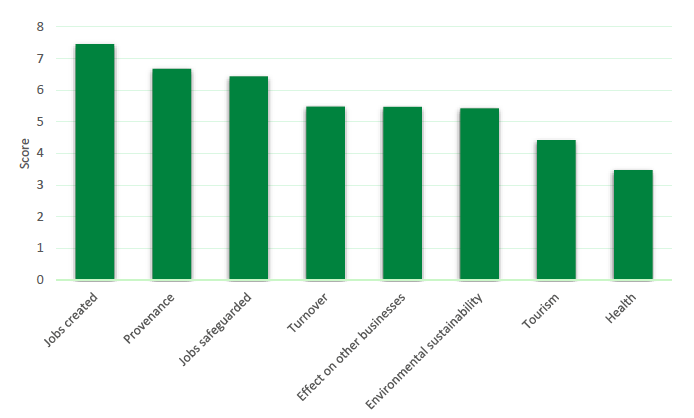
The following is an economic assessment of the top four metrics ranked: jobs created and safeguarded, provenance, and turnover. The aim is to assess the performance of the scheme according to projects awarded throughout the 2014-2020 programme. Figures are representative of projects at the point of monitoring. The majority of projects are still ongoing and the figures therefore have scope to change prior to and at the point of the end of the scheme.
Jobs created and safeguarded
Over all eight rounds, the predicted total number of jobs safeguarded from capital projects across all sectors was 5,784, and the total number of jobs created was 1,200, totalling 6,984. The figure is unequally distributed between sectors (figure 3) with meat creating and safeguarding substantially more jobs than all other sectors combined. Alcohol is the only sector to create more jobs than it safeguards, however combining all jobs this sector contributes the least to employment figures.
Figure 3: Number of jobs safeguarded and created[15]
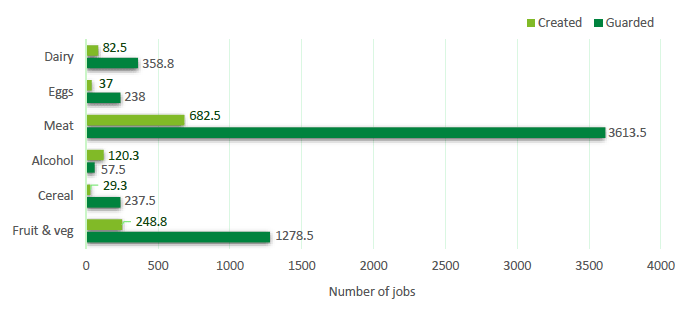
The shape of performance generally remains the same having adjusted for the different number of projects awarded per sector (figure 4 below). Adjustment involved applying fulltime equivalents (FTE) values, weighting jobs according to whether they were fulltime (1.0 FTE), part-time (0.5 FTE), or seasonal (0.25 FTE)[16]. Following this, the meat sector remained the clear leader for generating new and safeguarding existing jobs, and showed particular proficiency in safeguarding jobs. The alcohol sector remains the worst performer for safeguarding jobs and whilst it does create more jobs than all sectors apart from meat, the difference to those it outperforms is relatively marginal.
Figure 4: Average number of jobs safeguarded and created per project
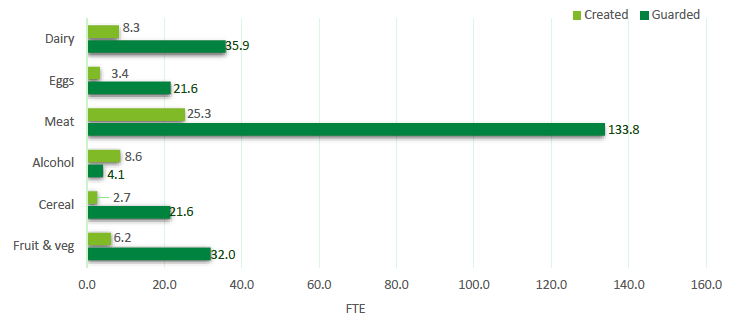
Combining all sectors, the average cost per job (FPMC expenditure divided by jobs) created or safeguarded (FTE-adjusted) was £12,614. Thus anything below this value performs better than expected and anything above performs below expected (figure 5). Only the eggs sector closely adheres to the predicted value. The meat sector once again performs very well, alongside dairy, costing only about a third of the predicted cost. Alcohol is the only sector to exceed the predicted cost (+/- 5% error margin) and it does so substantially by almost 300%, costing as much as cereal, meat, eggs, and dairy sectors combined and eight times that for jobs in the meat and dairy sectors.
Figure 5: Cost per job safeguarded/created
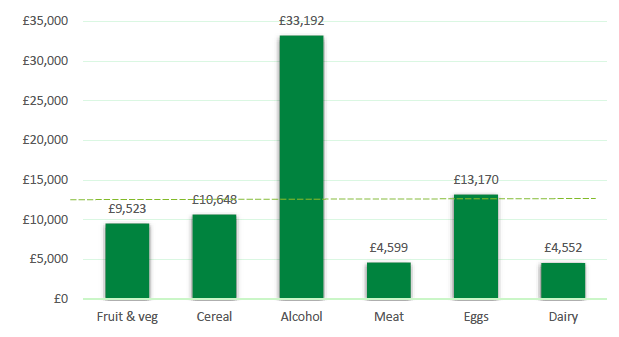
FPMC offers up to 40% of the total estimated project cost. Adjusting for this proportion, FPMC has contributed more in the region of 2800 jobs. However, if the projects would not have gone ahead without the grant then its contribution is arguably higher. FPMC is supposed to be regarded a last resort funder. That means projects should only be considering FPMC once they have no alternative.
The proportion of successful applicants who applied to FPMC as last resort was three times lower (21%) than unsuccessful applicants (61%). Nevertheless, 86% of successful applicants believed their project could not have gone ahead without FPMC, compared to half (50%) of unsuccessful projects, which contradicts the previous indication that the scheme was not accessing the intended claimants. Although the picture is therefore muddy, it suggests that in most cases jobs created and/or safeguarded would not have been without FPMC.
Perhaps a more realistic claim to FPMC’s employment contribution is to adjust by the proportion of projects that proceeded only because of the fund (86%). This estimates FPMC’s total contribution to number of jobs as 6,020.
Provenance
Provenance scored the second highest priority metric when ranked against other economic and non-economic measures (figure 2).
From an economic perspective, provenance can work as a partial but useful indicator because it alludes to trade pathways. While total provenance is unrealistic (i.e. all inputs sourced from Scotland), it is still desirable to maximise this to the optimal level.
There is potential added effect of provenance from tourism when food and drink products with strong Scottish branding are sold abroad, helping promote the region and attract visitors to Scotland.
Tourism was too indirect to measure for this report. Nevertheless it was possible to gather data about origins and destinations of products processed by businesses. FPMC projects are performing relatively well with 89% of projects sourcing inputs from Scotland, half (50%) are sourcing inputs from the rest of the UK (rUK), a third (32%) from EU and less than a sixth (14%) from beyond the EU (RoW).
Unsuccessful projects meanwhile predicted greater local provenance of input sources; all projects predicted or went on to achieve sourcing their inputs from Scotland. For regions outwith Scotland, the shape of the graph is similar to that of successful applicants, although the proportions are around 10% lower for rUK and RoW (figure 6).
Figure 6: Source of input products. Self-reported for successful (left) and unsuccessful (right) applicants.
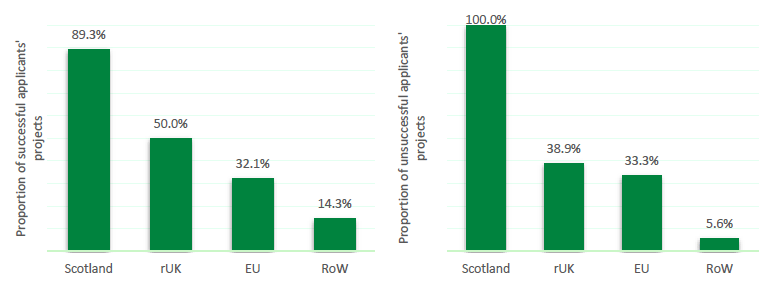
Most (86%) successful projects reported their outputs going to Scotland and rUK. Less than half (43%) to the EU, and a quarter (25%) go to RoW. Unsuccessful projects predicted better performance, with 89% supplying Scotland, even more (94%) to the UK, and provisions to EU and beyond averaged 20% higher than successful projects (figure 7).
Figure 7: Destination of output products self-reported for successful (left) and unsuccessful (right) applicants.
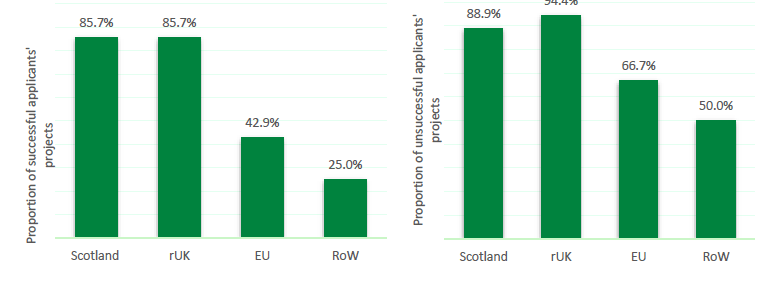
For both inputs and outputs, results suggest that the FPMC assessment process is effective at selecting projects with high local provenance and international destination of outputs, but is more effective at selecting out projects with even higher rates. At face value this suggests there is room for improvement, although this should be caveated (see limitations below).
Turnover
Turnover targets make up a part of the conditions set out to successful applicants.
Of the 43 projects assessed, 40 had available turnover data. Together, the projects represented all sectors and all of the 8 funding rounds throughout the 2014-2020 programme. Generally projects were achieving (n=3) or exceeding (n=16) their targets (figure 8) at point of monitoring (within first 5 years of award).
Figure 8: Turnover targets and achievements at point of monitoring
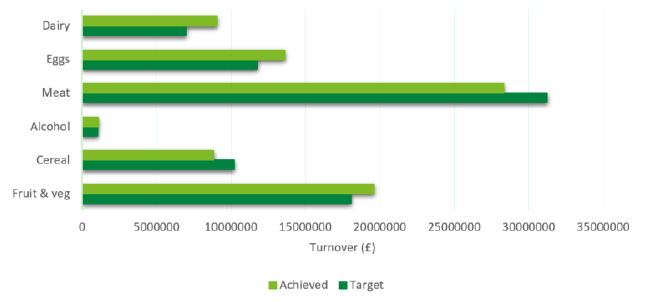
Fruit & vegetables, eggs, and dairy sectors were exceeding their targets. The fruit and vegetable sector had the most projects (n=13), making its result the more reliable of the sectors. Two fruit and vegetable businesses reported slightly exceeding their final targets whilst the rest had achieved theirs.
An alternative measure to turnover is pre-tax profits, which gives a clearer indication of performance after costs excluding tax are accounted for. Cumulative pre-tax profits were reported as almost £28 million. The meat sector was responsible for over a third of that and was the largest contributor overall, followed by the fruit and vegetable sector. Cereal made the smallest profits overall but outperformed alcohol which was the only sector to make a loss of almost a quarter of a million pounds (figures 9 and 10).
Figure 9: Cumulative pre-tax profit by sector
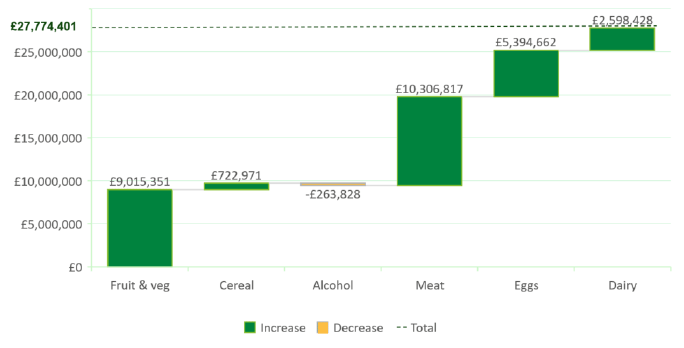
Figure 10: Distribution of pre-tax profit/loss by sector
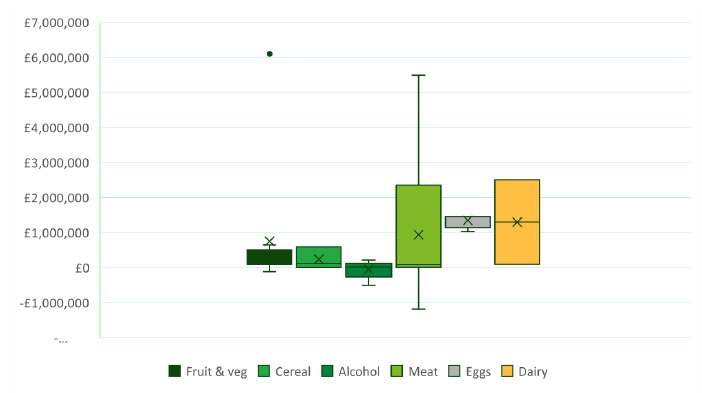
Limitations
There are a few limitations to this economic analysis that are worth highlighting. Turnover and pre-tax profits figures are tend to reflect values for the business as a whole but FPMC only partially contributes to a business. This, plus lack of imputation of displacement and additionality, and self-report of achieved and predicted figures (by applicants) usually some months or years prior to project-completion, mean this data cannot be an absolute or specific reflection of FPMC’s impacts. Whiskey has an especially long lead time to reach markets, which is overlooked by turnover figures.
Some sectors are only represented by a few projects for which data was available. Overall results for dairy and eggs, which both had small sample sixes (n=2 and 4, respectively), were therefore more sensitive to effects of a single under/ over-performing project.
For measuring provenance it was not realistic to ask about proportions of input/output products coming from/going to different regions in the survey, and recorded data was not consistent enough to be able to provide this information. True density of inputs and outputs may therefore change with a proportional study.
Summary
- Approximately 6000 jobs are supported by FPMC’s latest programme.
- The meat sector performs best overall across the different economic measures, contributing the most to jobs created and safeguarded, scoring equal best for grant cost per job created/safeguarded, and having the highest turnover and pre-tax profits.
- The alcohol sector performs the least well, contributing the smallest increase to jobs created and safeguarded (combined), costing the most grant per job created/safeguarded, and having the lowest turnover and the only pre-tax loss figures of all sectors. However alcohol exports may be the most beneficial of the sectors for promoting tourism through a strong Scottish branding.
- Provenance and destination of inputs and outputs for successful projects is generally good. It could be better although this is complicated by the need to balance against other sometimes economic and non-economic impacts.
- It is not always clear about whether economic figures provided by grant recipients refer to the business as a whole or the effects of the FPMC-funded component specifically. Being able to draw conclusions about the contributions of FPMC is therefore difficult given that FPMC only partially supports a single non-exclusive component of the total business.
2.2. A healthier Scotland
Of metrics prioritised, health[17] was ranked lowest by applicants in the survey (see figure 2). This isn’t to say that applicants did not see health as a priority, but that it was perceived as least important when compared to the other metrics. There was clear polarity of response amongst unsuccessful applicants, none of whom ranked health above the bottom three of all metrics (figure 11.).
Figure 11: Spread of health rankings relative to alternative metrics by successful (left) and unsuccessful (right) survey respondents.
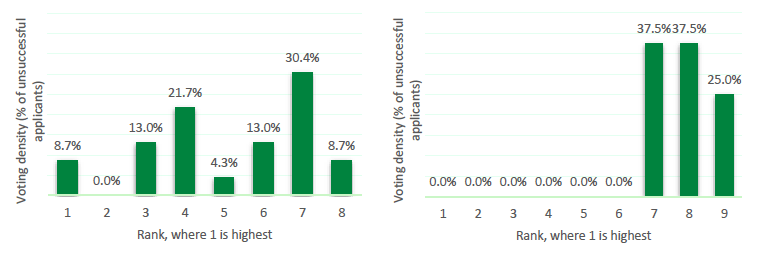
As well as health being perceived lower priority, most applicants believed that the type of output product/s, their nutritional quality, or the cost to consumers would have or did see any change as a result of the FPMC-funded project. Increase in the range of markets supplied was the only health measure to have improved for the majority. Market reach was also the most economically related measure, which may have motivated this outcome.
Range of markets accessed can be regarded a health indicator because it is likely that where the range increases, the range of consumers accessed also increases. Only when healthy or healthier (e.g. fresher) produce is accessed by a broader range of people is there more nation-wide consumption of these products and thereby more broad impact of potential health benefits.
Some FPMC-funded businesses are simultaneously supplying their product/s to both middle (e.g. Morrisons) and lower priced (e.g. Aldi) supermarkets as well as independent suppliers such as high street butchers, demonstrating this broad market reach. Further research into type of markets, products, and consumers would help to build better understanding about the extent and nature of health benefits from increased market reach.
2.2.1. Regulating the health objective in FPMC
Health is central to public interest, the Scottish Government’s wider agenda, and FPMC’s main objectives. Applications are already assessed by experts for their contribution to health at point of application (see Appendix A), awarded on a scale between 1 (lowest) and 5 (highest). Some sectors are more inherently healthy than others when considering their products’ association with healthy consumption.
Figure 12 shows the spread of scores for projects assessed over rounds 7 and 8. It reveals eggs as the highest scoring sector and the sector sharing the narrowest variation in scores alongside fruit and vegetable (second highest scoring) and dairy (third highest) sectors. Average scores for projects of the cereal, meat, and dairy sectors are similar to one another. Cereal has the largest variation in scores but alcohol performs worst and its average is skewed towards the lower end of its range, at 1.0, which is the lowest score possible.
Figure 12: Average and range of health assessment scores for round 7 and 8 projects by sector
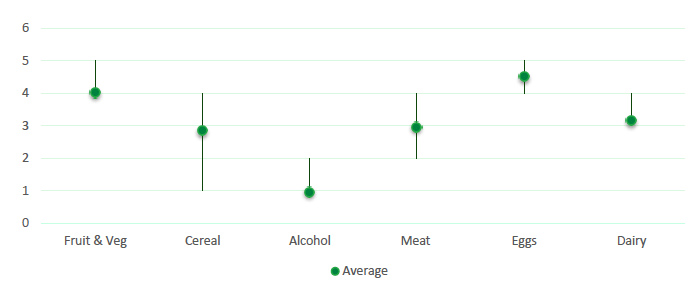
The survey asked all applicants about whether and how they would like FPMC to change in its application and assessment processes to reflect the importance of health. Generally it was felt that assessment was adequate enough as it is and that enforcing stricter criteria would be more problematic. It was expressed that making eligibility more contingent upon demonstrable health measures conflicts with the purpose of this grant to access businesses needing financial assistance, because the costs of incorporating the required changes may override the grant’s benefits.
Interviewees welcomed stricter requirements for health but only given they were required of all food and drink processing businesses through generalised upstream policy in order to secure a ‘level playing field’.
Without a level playing field, interviewees felt that the special measures applicants must undertake to receive the grant would not make an application a viable business decision. Furthermore, market pressures to improve healthiness of products are already active, driven by consumer preferences for example towards lower fat and vegan products. Overall, the opinion was that enforcing health regulations should not and need not be regarded as FPMC’s responsibility.
2.2.2. Rethinking the health objective
Despite the apparent lack of focus upon health improvement as a key driver for businesses applying to FPMC, there is data suggesting that the grant is already having incidental benefits upon health. Market range (outlined above) is one example, but health is increasingly understood as an holistic entity not limited to physical health alone. There is therefore room to consider the broader, less obvious but equally important, health impacts. A broader perspective of health has been formally recognised by the World Health Organisation for over 80 years, which defines health as “state of complete physical, mental and social well-being and not merely the absence of disease or infirmity”[18].
Following this, meaningful health impacts can be found in measures more directly or traditionally affiliated with economic gain. Outlined below, jobs created, job security, and staff morale are examples for which data was collected as part of this report.
- Jobs created
Employment is linked to better health outcomes than unemployment due in part to financial assets with which to buy essential provisions, but also due to better mental and social health[19]. As it implies membership to a group, employment may boost people’s sense of worth, purpose, and belonging[20]. Many positions allow for relationships to form between colleagues or even clients, building social capital which describes the emotional (support), informational (advice), and sometimes physical (material) resources derived from sustained inter-person relationships (ibid.). All of these indicators have been repeatedly and significantly linked to better social, mental, physical, and thereby all-round wellbeing (ibid.). A substantial majority (82%) of businesses reported a positive impact on their staffing numbers as a result of the FPMC-funded project. No business reported decrease in staffing numbers.
- Job security
“[the scheme] has given staff a huge boost over job security”
Survey respondent (successful)
Stable employment supports mental health, reducing stress, anxiety, and depression[21]. An overwhelming majority of FPMC-funded projects (82%) reported enhanced job security. A small minority (4%) reported reduced job security, although there was no further information to understand the forces behind this, which may have resulted from wider problems emanating from outside the project.
- Staff morale
“[the scheme] gives confidence to our staff and our customers.”
Survey respondent (successful)
Morale improves the quality and experience of the work environment, helping reduce stress and boost mental health. Chronic stress adversely affects physical health[22] and therefore improving staff morale may help to protect general wellbeing. Morale very likely goes hand in hand with other contextual factors including job security and so there is likely to be an interdependence between factors. The majority of businesses (82%) agreed that staff morality had improved as a result of the FPMC-funded project. Once again, a small minority (4%) believed staff morale had been damaged, though the data cannot indicate the reasons for this and, because 4% represents one individual, the same individual may account for the negative result across staff morale and job security.
Beyond financial and social statuses, human health links to broader environmental conditions in numerous and important ways. Pesticide use, pollution, and climatic conditions, for example, are linked to a host of physical health disorders – from cancers, cardiovascular disease, respiratory conditions, and malnutrition - via multiple pathways[23]. One pathway is that climate affects the quality and quantity of agricultural food production that in turn directs dietary health. Human health is not always the first association made to environmental sustainability, though they are so inextricably linked that health depends upon serious and committed global efforts to reverse the climate change emergency by all nations.
Summary
- The eggs sector scored highest for health at assessment. The alcohol sector scored lowest.
- Health is not actively prioritised for FPMC by applicants. Nevertheless there is widespread agreement that health should remain as important to FPMC as it already is in order to stay compliant with wider Scottish Government policy.
- Although not actively pursued, health is still partially, if inadvertently, benefitted from FPMC through potentially increasing the range of customers accessed secondary to a wider range of markets supplied.
- There may be room for a more flexible understanding of health that extends beyond its traditional notion as merely physical, towards a more updated and comprehensive understanding that regards physical, social, and mental wellbeing simultaneously.
2.3. A more environmentally sustainable Scotland
Evidence of environmental sustainability is scored by the assessors in a similar way to health, from 1(lowest) to 5(highest). The fruit and vegetable sector held the highest average score across round 7 and 8 projects. Score variation was narrowest for the eggs sector. Cereal had the largest variation and was the only sector with projects being awarded the lowest possible score of 1, although its average score was still higher than alcohol, which was on average the lowest scoring sector (figure 13).
Figure 13: Average and range of environmental sustainability assessment scores for round 7 and 8 projects by sector
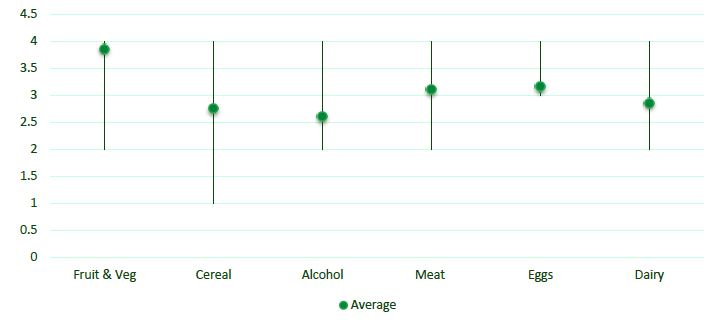
When ranked by applicants against other priorities, environmental sustainability occupied a middling position overall, scoring higher than health. Opinion was also less variable across both applicant groups (figure 14) than it was for health (figure 11).
Figure 14: Spread of environmental sustainability rankings relative to alternative metrics by successful (left) and unsuccessful (right) survey respondents.
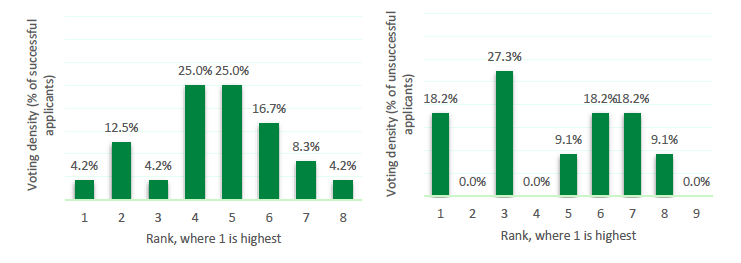
Less than a third of grant recipients (29%) believed that the nature of the output products became more environmentally sustainable as a result of the grant; the majority (64%) believed there was no change. Nevertheless there were indications of some positive impacts for the environment where the majority believed that processing methods (54%) and people’s perceptions (57%) had become more environmentally sustainable as a result of the grant-assisted project. No business reported that the project had reduced their environmental sustainability across any measure.
2.3.1. Regulating environmental sustainability in FPMC
Improving environmental sustainability can involve expensive modifications and does not tend to accelerate output compared to non-environmentally sustainable processes. Therefore, sustainability efforts are more likely to be systematically implemented. As for health, market pressures originating from consumer preferences are likely to incentivise these implementations because markets respond to customer demand and this in turn determines the behaviours of processing businesses that supply those markets.
Customers are increasingly literate about environmental sustainability and this affects the types of products they buy, which trends increasingly towards vegan, recyclable or minimised packaging, and local provenance. Provenance supports environmental sustainability by reducing food miles.
Grant recipients reported high provenance of input products, 89% sourcing from within Scotland. A clear minority (14%) sourced products from RoW (figure 16). Therefore, FPMC is supporting environmental sustainability through reducing emissions by funding projects with generally more localised provenance. However the data does not allude to proportions of inputs by region, which would be more informative. Additionally, provenance generally indicates lower food miles but there are exceptions whereby, for example, transporting between the Scottish borders in the South and the outermost Scottish islands to the North can be farther than the distance between some Scottish and EU regions.
Figure 16: Geographical source of input products for grant-assisted projects
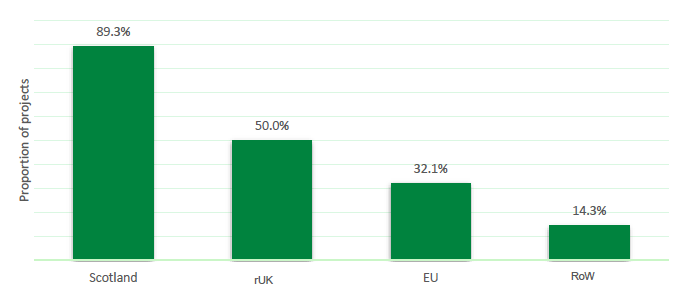
Whether and how environmental sustainability should be more strictly regulated as part of FPMC assessment was met with similar logic to that described for health: firstly, stricter regulations are welcomed but only when asked of all businesses rather than those in need of grant assistance and, secondly, incentives for environmental sustainability were already in place from other directions, namely market pressures from consumer demand. Therefore once again FPMC was not perceived as an appropriate place to enforce stricter regulation for environmental sustainability.
“Environmental sustainability involves many factors of which power consumption and mileage are only two factors. Packaging design, recycling of materials and heat generated by processes, design of processes, and changing to green power will all contribute to environmental sustainability. In our opinion unless a grant application is specific to an environmental sustainability project, the time taken to monitor and measure the various factors we have outlined would be both complex, time consuming and could create additional costs which could make it very onerous for small businesses and so deter them from making a grant application which could important to the development of the business and the employment that business creates.”
Interviewee (successful)
Summary
- The fruit and vegetable sector scored highest at assessment of environmental sustainability. The alcohol sector scored lowest.
- Processing methods and perceptions of environmental sustainability improved as a result of the grant-assisted project.
- Environmental sustainability should remain as important as it currently is for FPMC.
- FPMC is not considered an appropriate or effective place to enforce stricter environmental assessment criteria than it currently is. Instead this was seen to be the role of blanket government policy that effects all businesses equally, wherein applicants welcomed reform.
2.4 Special case: the alcohol sector
Given FPMC’s core objectives of health and environment alongside economy, the inclusion of alcohol projects has been a source of split opinion and sometimes contention amongst interviewees.
Alcohol is a relatively new addition to FPMC’s eligible businesses, having only been considered since 2014. There is general confusion as to why this happened but the assumption from experts and applicants alike is that economic benefit was the driving factor. However, most did not believe this justified supporting production of a class of products perceived as largely if not totally devoid of benefit to health and environment.
Alcoholism in Scotland is a persistent problem, attributed to 3705 deaths and cost £3.6billion in Scotland in 2015[24]. Health aside, experts commented that alcohol businesses tended to generate profit relatively fast and therefore questioned the true need of the sector to be supported by FPMC when it seems they are more capable of self-sufficiency than other sectors. Note, however, that economic assessment (section 1) of 36% of the alcohol business awarded FPMC found turnover and pre-tax profits to be lowest of all sectors.
Contention was evident in comments about funds being detracted from projects in other sectors that were inherently healthier and/or environmentally friendly, when they were rejected in favour of alcohol projects.
There is however counter argument that to the contrary suggests alcohol can complement all of FPMC’s objective triad:
(a) Health - alcohol is not going to confer immediate and direct health advantage to its consumers and may instead be damaging. It is only once we look beyond consumption that we build a more comprehensive understanding (see section 2.2.2.). In brief we see that: (1) alcohol exports are high, though this is only beneficial to Scotland by redirecting consumption elsewhere, and even minimal national sales still contribute to potential Scottish consumption. (2) Economic benefits to the business can have wider local community benefits. Some of these relate to tourism; strong branding in products sold internationally can help to attract visitors and whisky is likely to perform well amongst other food and drink products because it is sold widely in high quantity; breweries and distilleries often function as visitor attractions. Other benefits include (3) jobs and (4) improved sense of place within the local region. One alcohol business was awarded primarily because of its anticipated benefits for the otherwise very remote local region.
(b) Environmental sustainability - (1) there are examples of non-FPMC-funded projects that are powered by renewable energy. (2) Supporting the alcohol sector relies upon and therefore supports the cereals sector which is arguably more environmentally sustainable than some alternative practices and in any case supports cereal sector economy.
Having to look much wider for benefits makes alcohol’s obvious alignment to FPMC’s objectives something to consider looking forward (see recommendations).
Contact
Email: socialresearch@gov.scot
There is a problem
Thanks for your feedback